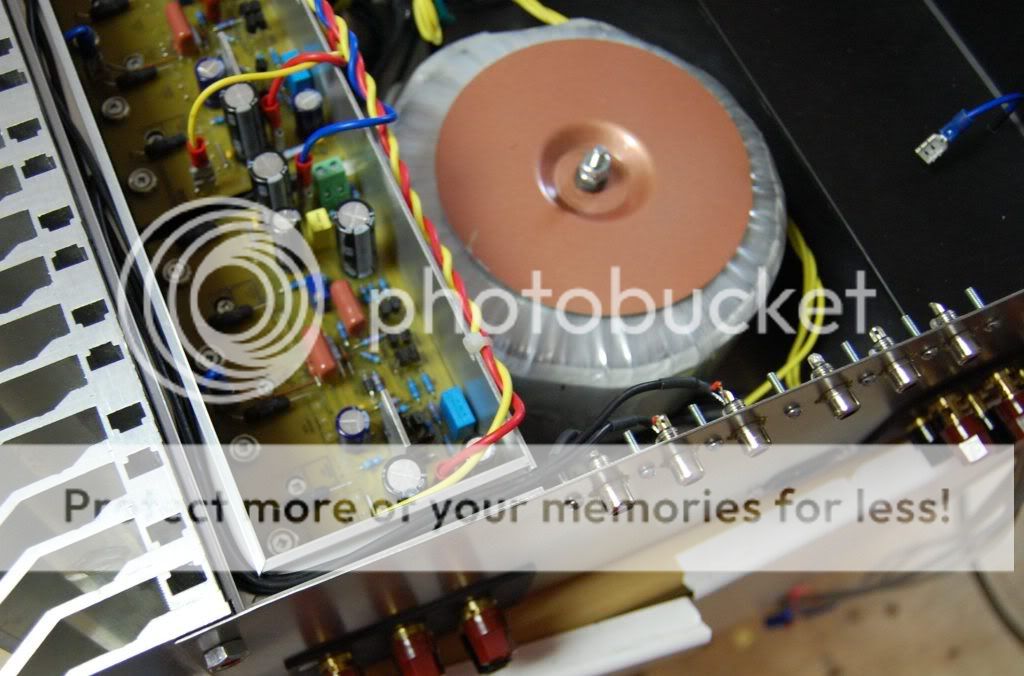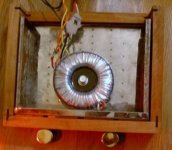That is a question of Trial-&-Error. As a rule of thumb there should be a minimum of 20..30 mm, which translates to 0.8..1.2". The more the better.
One advantage of toroids is their narrower stray magnetic field compared to other transformers. And there are examples, where toroids are used very near to the audio components without problems.
On the other hand we have seen threads, where the transformer had to be put into a separate case, because it would couple into the audio signal at any distance.
By the way, the original Gaincard uses the transformer in a separate enclosure.
One advantage of toroids is their narrower stray magnetic field compared to other transformers. And there are examples, where toroids are used very near to the audio components without problems.
On the other hand we have seen threads, where the transformer had to be put into a separate case, because it would couple into the audio signal at any distance.
By the way, the original Gaincard uses the transformer in a separate enclosure.
pacificblue said:Don't expect too much of shielding a transformer. At those low frequencies you need an extremely efficient shielding material like mu-metal, which is hard to get by and extremely expensive.
Oh, it has an effect all right. Anytime you put a conductive barrier between a magnetic source and an area you want to protect, there will be some reduction. It may not be 100% or even close to that but it beats doing nothing at all.
I can say that if a quiet amp is important to you, every effort to reduce noise and hum are well worth it.
Re: One picture worth a 1000 words
Where's the heatsink going to go?
limono said:Steampuck gainclone
Where's the heatsink going to go?
The stainless steel chassis is covered with riveted tick copper strips. I'll just screw chip amps to the flat alu plates and the plates to the sides od chassis and the whole chassis will be a heat sink. Should be enough .Original Gaincard doesn't seem to have excessive heat sinks.
Regards, L
Regards, L
Yes , I've read your post , very good. I will test the amp temperature and how the transformer proximity affects the circuit.
Casing was just past riveting exercise and I thought I can use it for an amp.If it doesn't work well, I'll find a box for transformer and put some heatsinks into the case. I've read quite a few post with people complaining about hum problems with gainclone amps.
Anyway I'll get chips and PCB's from a friend this week. Transformer is 25V-0-25V from the size of it ,I estimate 150VA .I was suprised a little that the gainclone I've borrowed is on par with refurbed fisher 500c receiver .
The point is the girl liked crude box and the fact that it looks "very
handmade"
Thanks for your help and remarks guys .I'll report back when I have semi operational circuit .
Regards, L
Casing was just past riveting exercise and I thought I can use it for an amp.If it doesn't work well, I'll find a box for transformer and put some heatsinks into the case. I've read quite a few post with people complaining about hum problems with gainclone amps.
Anyway I'll get chips and PCB's from a friend this week. Transformer is 25V-0-25V from the size of it ,I estimate 150VA .I was suprised a little that the gainclone I've borrowed is on par with refurbed fisher 500c receiver .
The point is the girl liked crude box and the fact that it looks "very
handmade"
Thanks for your help and remarks guys .I'll report back when I have semi operational circuit .
Regards, L
limono said:I've read quite a few post with people complaining about hum problems with gainclone amps.
Gaincloning is very attractive for people with little knowledge and experience in electronics, if any. The higher percentage of ground loops must be attributed to that, and not to being chipamps.
Mu-metal shielding is not particularly that effective with toroidal power transformers as pacificblue mentioned, due to it’s low saturation levels. Mu-metal is more effective with small signal devices such as microphone and line input transformers as these operate at very low flux densities. 50 and 60Hz power toroids are generally run at much higher flux densities, particularly those that are not specifically designed for audio or small signal circuitry, and some of the leakage patterns on these components can easily saturate Mu-metal shielding reducing it’s effectiveness
On a decently wound power toroid (and you will be amazed at how badly some of them are wound), the worst area for leakage is at the lead outs of the transformer and especially on transformers that bring all the lead outs together in one bunched up section (probably around 90% of off the shelf toroidals). This sort of leakage can be very directional and you can often rotate the transformer until the induced noise is at a minimum, as long as you have left the leads long enough.
For the simplest and often completely effective DIY shielding of a toroid, the best way to go would be strip an old toroid down to the bare core, break the lamination and unwind enough core “strip” to tightly wind around the periphery of the toroid you wish to shield. Ideally the height of the bare core strip should be the same height of the toroid you are shielding and you should use at least two to three complete “turns” of strip around the outside of the transformer, the more layers the better. This material will not saturate under any leakage level the transformer can put out under non saturated conditions and will be very effective in containing any leakage flux. It looks like this style of shielding has been used incorporated in the toroid in John’s large photo above
Be warned however that most general purpose toroidal power transformers on the market are designed for economy and are wound with little care and some of the leakage patterns on these components can be almost impossible to eradicate if used in sensitive audio or instrumentation applications
Cheers
Ray
On a decently wound power toroid (and you will be amazed at how badly some of them are wound), the worst area for leakage is at the lead outs of the transformer and especially on transformers that bring all the lead outs together in one bunched up section (probably around 90% of off the shelf toroidals). This sort of leakage can be very directional and you can often rotate the transformer until the induced noise is at a minimum, as long as you have left the leads long enough.
For the simplest and often completely effective DIY shielding of a toroid, the best way to go would be strip an old toroid down to the bare core, break the lamination and unwind enough core “strip” to tightly wind around the periphery of the toroid you wish to shield. Ideally the height of the bare core strip should be the same height of the toroid you are shielding and you should use at least two to three complete “turns” of strip around the outside of the transformer, the more layers the better. This material will not saturate under any leakage level the transformer can put out under non saturated conditions and will be very effective in containing any leakage flux. It looks like this style of shielding has been used incorporated in the toroid in John’s large photo above
Be warned however that most general purpose toroidal power transformers on the market are designed for economy and are wound with little care and some of the leakage patterns on these components can be almost impossible to eradicate if used in sensitive audio or instrumentation applications
Cheers
Ray
- Status
- This old topic is closed. If you want to reopen this topic, contact a moderator using the "Report Post" button.
- Home
- Amplifiers
- Chip Amps
- Proximity of toroid PT from Gainclone boards

